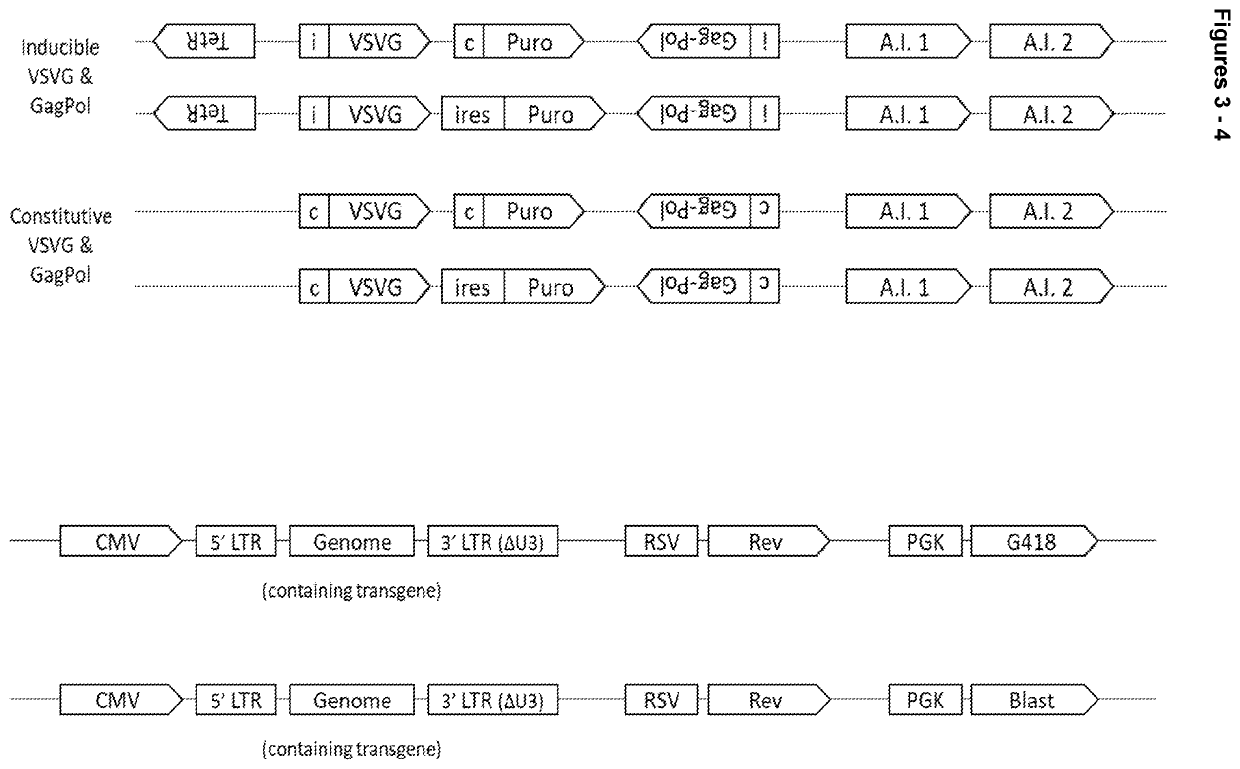Retroviral vectors
a technology of retro/lentivirus and vectors, applied in the field of nuclear acid molecules, can solve the problems of retro/lentivirus vectors used for transgene and shrna expression, typically disabled retro/lentivirus vectors, ability to replicate and cause disease, etc., and achieve the effect of reducing the risk of replication-competen
- Summary
- Abstract
- Description
- Claims
- Application Information
AI Technical Summary
Benefits of technology
Problems solved by technology
Method used
Image
Examples
example 1
ation of Factors Supporting Viral Protein Expression
[0130]The viral glycoprotein, VSV-G, from Vesicular Stomatitis Virus, was co-expressed with a panel of apoptosis inhibitors. We were able to identify several molecules which supported the constitutive expression of VSV-G, and were able to establish a stable cell line via antibiotic selection. This data was subsequently used to select the preferred apoptosis inhibitors to be included in the final Lentiviral packaging and producer cell lines, described in the latter Examples.
[0131]HEK293 suspension cells were transfected using PEI reagent with a range of expression vectors encoding VSV-G operatively linked to a Puromycin selection marker via IRES, as well as a number of apoptosis inhibitor genes. Stable pools were established by media exchange in selective media every 3-4 days. Due to the toxicity of the VSV-G gene, which is constitutively expressed, stable pools took an extended period to establish. The results are shown in FIG. 1. ...
example 2
n of Constructs for Lentiviral Packaging and Producer Cell Line Construction
[0133]Four constructs were produced as illustrated in FIG. 3. The constructs paired VSV-G and gag-pol genes together using a Puromycin selection marker, and rev and genome together using either a G418 or Blasticidin selection marker.
[0134]Each cassette can be broken down into functional components as follows:
VSV-G Cassette
[0135]Inducible promoter (PGK CMV fusion promoter converted into an inducible promoter by the addition of two TetO sites in strategic positions) or Constitutive promoter (a PGK CMV fusion promoter)[0136]5′UTR=human triose phosphate isomerase (TPI) intron[0137]CDS (VSV-G codon optimised for expression in HEK293 cells)[0138]Rabbit beta-globin polyA signal
GagPol Cassette
[0139]Inducible promoter (CMV converted into an inducible promoter by the addition of two TetO sites in strategic positions) or Constitutive promoter (CMV)[0140]5′UTR (Human beta-globin intron)[0141]CDS (wild type HIV1 GagPol)[...
example 3
of Constructs for Lentiviral Packaging and Producer Cell Line Construction in Transient Context
[0158]In order to evaluate the functionality of the vectors to be used in stable cell lines, they were first used to generate Lentiviral particles in transient experiments in adherent cells. This allowed benchmarking against standard 4-vector transient expression vectors.
[0159]Adherent 293T cells were transfected with 2, 3 or 4-plasmid lentiviral packaging systems which included constructs (constitutive or inducible) generated for the purposes of stable lentivirus producer cell line construction. Throughout, eGFP was used as the transgene in the genome vector.
[0160]The lentivirus containing supernatant was collected after 72 hours, serially diluted in DMEM and used to infect adherent 293 cells. After 72 hours, the cells were trypsinized and analysed on the flow cytometer for eGFP signal.
[0161]Data from serial dilution at which 10-20% eGFP positive (i.e. transduced) cells had been achieved ...
PUM
| Property | Measurement | Unit |
|---|---|---|
| Fraction | aaaaa | aaaaa |
| Fraction | aaaaa | aaaaa |
| Fraction | aaaaa | aaaaa |
Abstract
Description
Claims
Application Information
 Login to View More
Login to View More - R&D
- Intellectual Property
- Life Sciences
- Materials
- Tech Scout
- Unparalleled Data Quality
- Higher Quality Content
- 60% Fewer Hallucinations
Browse by: Latest US Patents, China's latest patents, Technical Efficacy Thesaurus, Application Domain, Technology Topic, Popular Technical Reports.
© 2025 PatSnap. All rights reserved.Legal|Privacy policy|Modern Slavery Act Transparency Statement|Sitemap|About US| Contact US: help@patsnap.com



